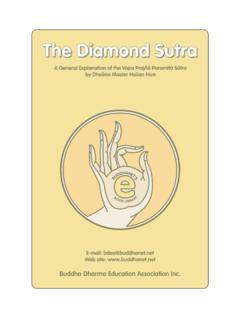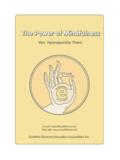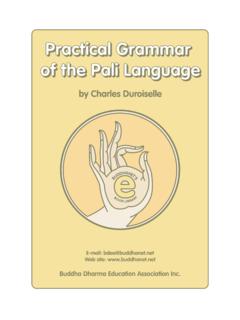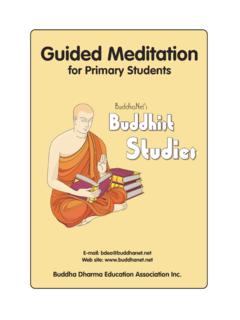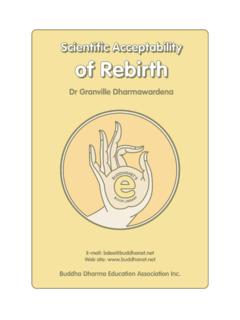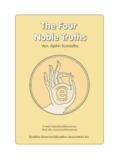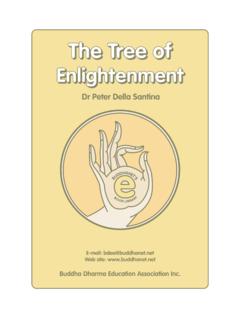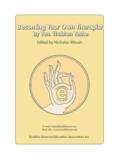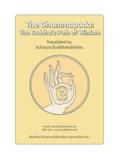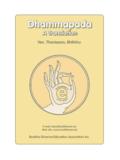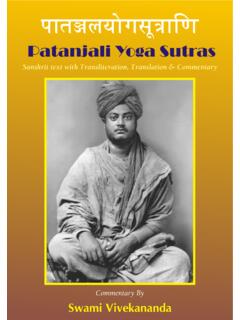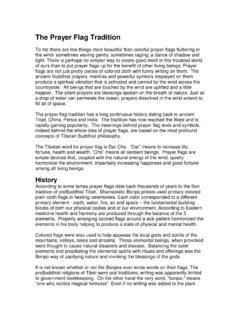Transcription of Manual of Zen Buddhism: Introduction
1 EBUDDHANET'SBOOKLIBRARYE-mail: site: Dharma Education Association Teitaro Suzuki, of Zen BuddhismManual of Zen buddhism Manual OF ZEN buddhism DAISETZ TEITARO SUZUKI, Professor of Buddhist Philosophy in the Otani University, Kyoto [1935] Set in pdf by M. G. Sheet, Baghdad, Iraq 2005 CONTENTS EDITOR'S FOREWORD iv EDITOR'S NOTE v AUTHOR'S PREFACE vi I. GATHAS AND PRAYERS 1 1. On Opening the sutra 2 2. Confession 2 3.
2 The Threefold Refuge 2 4. The Four Great Vows 3 5. The Worshipping of the Sarira 3 6. The Teaching of the Seven Buddhas 3 7. The Gatha of Impermanence 4 8. The Yemmei Kwamon Ten-Clause sutra 4 9. Prayer on the Occasion of Feeding the Hungry Ghosts 4 10. General Prayer 6 11. Prayer of the Bell 7 II.
3 THE DHARANIS 8 1. Dharani of Removing Disasters 9 2. Dharani of the Great Compassionate One 9 3. Dharani of the Victorious Buddha-Crown 10 III. THE SUTRAS 12 1. The Prajnaparamita-hridaya- sutra , or Shingyo (complete) 13 2. The Kwannongyo, or "Samantamukha Parivarta" (complete) 16 ii3. The Kongokyo, or Vajracchedika (the first half and extracts from the second half) 23 4.
4 The Lankavatara sutra , or Ryogakyo (extracts) 32 5. The Ryogonkyo, or Surangama sutra (r sum ) 42 IV. FROM THE CHINESE ZEN MASTERS 48 1. Bodhidharma on the Twofold Entrance to the Tao 49 2. The Third Patriarch on "Believing in Mind" 51 3. From Hui-neng's Tan-ching 56 4. Yoka Daishi's "Song of Enlightenment" 61 5. Baso (Ma-tsu) and Sekito (Shih-tou) 70 6. Obaku's (Huang-po) Sermon from "Treatise on the Essentials of the Transmission of Mind" 78 7. Gensha on the Three Invalids (from the Hekiganshu or Pi-yen Chi) 83 8. The Ten Oxherding Pictures, I 89 The Ten Oxherding Pictures, II 93 V. FROM THE JAPANESE ZEN MASTERS 99 1.
5 Daio Kokushi on Zen 100 2. Daio Kokushi's Admonition 101 3. Daito Kokushi's Admonition and Last Poem 102 4. Kwanzan Kokushi's Admonition 103 5. Muso Kokushi's Admonition 104 6. Hakuin's "Song of Meditation" 105 VI. THE BUDDHIST STATUES AND PICTURES IN A ZEN MONASTERY 107 Buddhas; Bodhisattvas; Arhats; Protecting Gods; Historical Figures 108 iii EDITOR'S FOREWORD TO SECOND EDITION Daisetz Teitaro Suzuki, , Professor of Buddhist Philosophy in the Otani University, Kyoto, was born in 1870.
6 He is probably now the greatest living authority on Buddhist philosophy, and is certainly the greatest authority on Zen buddhism . His major works in English on the subject of buddhism number a dozen or more, and of his works in Japanese as yet unknown to the West there are at least eighteen. He is, moreover, as a chronological bibliography of books on Zen in English clearly shows, the pioneer teacher of the subject outside Japan, for except for Kaiten Nukariya's Religion of the Samurai (Luzac and Co., 1913) nothing was known of Zen as a living experience, save to the readers of The Eastern Buddhist (1921-1939), until the publication of Essays in Zen buddhism (Volume I) in 1927. Dr. Suzuki writes with authority.
7 Not only has he studied original works in Sanskrit, Pali, Chinese and Japanese, but he has an up-to-date knowledge of Western thought in German and French as well as in the English which he speaks and writes so fluently. He is, moreover, more than a scholar; he is a Buddhist. Though not a priest of any Buddhist sect, he is honoured in every temple in Japan, for his knowledge of spiritual things, as all who have sat at his feet bear witness, is direct and profound. When he speaks of the higher stages of consciousness he speaks as a man who dwells therein, and the impression he makes on those who enter the fringes of his mind is that of a man who seeks for the intellectual symbols wherewith to describe a state of awareness which lies indeed "beyond the intellect".
8 To those unable to sit at the feet of the Master his writings must be a substitute. All these, however, were Out of print in England by 1940, and all remaining stocks in Japan were destroyed in the fire which consumed three-quarters of Tokyo in 1945. When, therefore, I reached Japan in 1946, I arranged with the author for the Buddhist Society, London--my wife and myself as its nominees--to begin the publication of his Collected Works, reprinting the old favourites, and printing as fast as possible translations of the many new works which the Professor, self-immured in his house at Kyoto, had written during the war. This undertaking, however, was beyond the powers of the Buddhist Society, and we therefore secured the assistance of Rider and Co.
9 , who, backed by the vast resources of the House of Hutchinson, can honour the needs of such a considerable task. Of Zen itself I need say nothing here, but the increasing sale of books on the subject, such as The Spirit of Zen by Alan Watts (Murray), and the series of original translations of Chinese Zen Scriptures and other works published by the Buddhist Society prove that the ivinterest of the West is rising rapidly. Zen, however, is a subject extremely easy to misunderstand, and it is therefore important that the words of a qualified Master should come readily to hand. CHRISTMAS HUMPHREYS President of the Buddhist Society, London 1948 EDITOR'S NOTE TO SECOND EDITION All references to the Author's Essays in Zen buddhism , Series One and Two, and to his Introduction to Zen buddhism , are to the second edition of these works, published in "The Complete Works of D.
10 T. Suzuki." v PREFACE TO FIRST EDITION In my Introduction to Zen buddhism (published 1934), an outline of Zen teaching is sketched, and in The Training of the Zen Monk (1934) a description of the Meditation Hall and its life is given. To complete a triptych the present Manual has been compiled. The object is to inform the reader of the various literary materials relating to the monastery life. Foreign students often express their desire to know about what the Zen monk reads before the Buddha in his daily service, where his thoughts move in his leisure hours, and what objects of worship he has in the different quarters of his institution. This work will partly, it is hoped, satisfy their desire. Those who find my Essays too bulky or too elaborate may prefer these smaller works on Zen.
